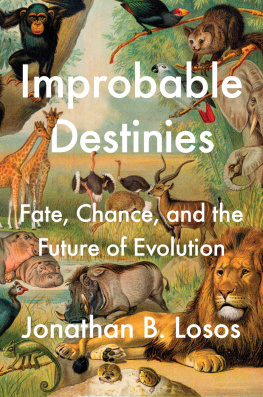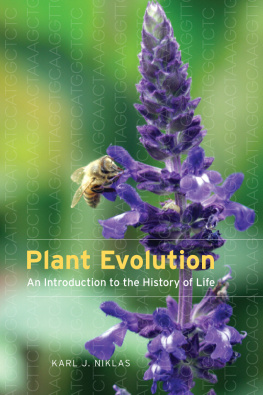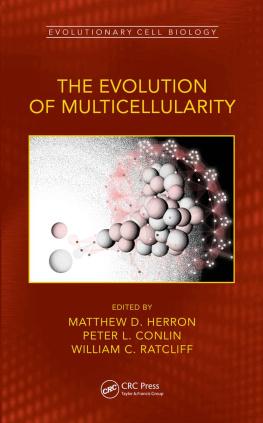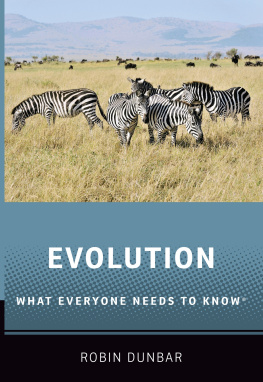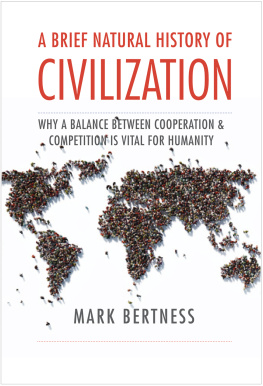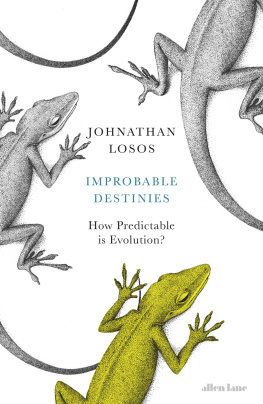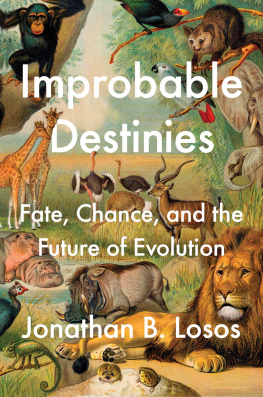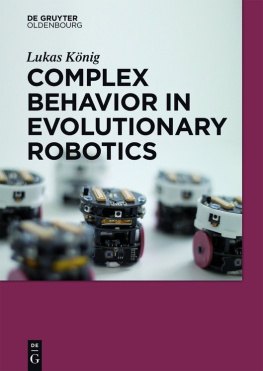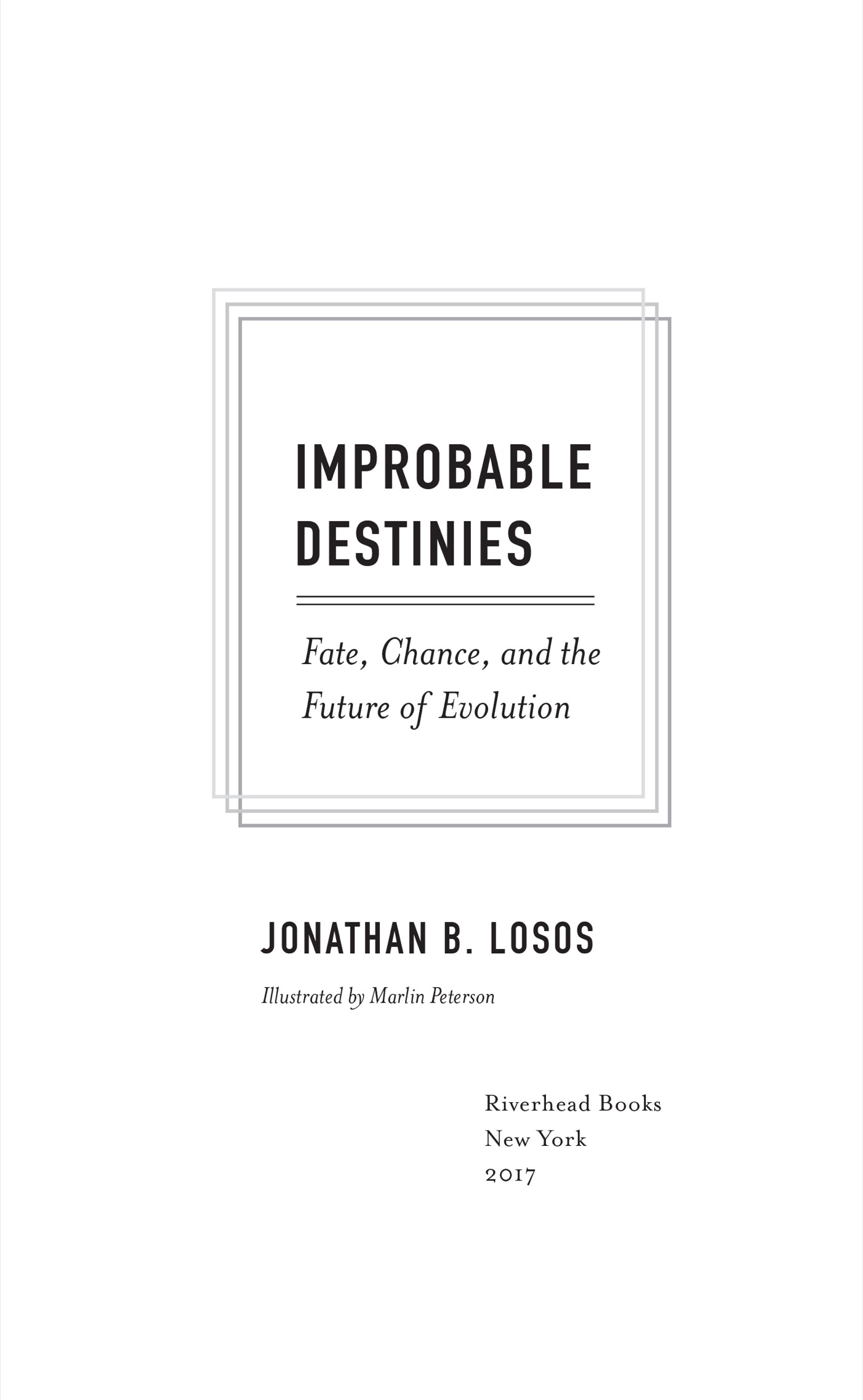Copyright 2017 by Jonathan B. Losos
Penguin supports copyright. Copyright fuels creativity, encourages diverse voices, promotes free speech, and creates a vibrant culture. Thank you for buying an authorized edition of this book and for complying with copyright laws by not reproducing, scanning, or distributing any part of it in any form without permission. You are supporting writers and allowing Penguin to continue to publish books for every reader.
Names: Losos, Jonathan B.
Title: Improbable destinies : fate, chance, and the future of evolution / Jonathan B. Losos.
Description: New York : Riverhead Books, 2017. | Includes bibliographical references and index.
To my wife, Melissa Losos, and my parents, Joseph and Carolyn Losos, for their love and support
Preface
L ike many children, I went through a dinosaur phase. I was legendary at nursery school for showing up every day with my basket full of plastic dinosaurs: Allosaurus, Stegosaurus, Ankylosaurus, Tyrannosaurus rex. I had em all, or at least all of the twenty or so species available back then (kids today have it so much better).
Unlike most kids, I never grew out of the phase. I still have my toy dinos, many more now; I still know their names, can even still pronounce Parasaurolophus (pair-uh-soar-ahl-oh-fuss). But my interests have shifted to living reptiles: snakes, turtles, lizards, and crocodilians.
To a large extent, this shift was prompted by a rerun of the old TV show Leave It to Beaver, specifically the episode in which Wally and the Beave buy a mail-order baby alligator and hide it in the bathroom. Needless to say, when Minerva the housekeeper finds it, hilarity ensues. Thinking that this was a great idea and knowing that pet stores in those days (the early 1970s) sold baby caimans, the Central and South American version of the alligator, I petitioned my mother. Not being the sort of woman who likes to say no, she suggested we contact a family friend, Charlie Hoessle, the deputy director of the Saint Louis Zoo, expecting him to put the kibosh on the idea. Every day when my father returned home from work, my first question was Did you talk to Mr. Hoessle today? By nature not especially patient (particularly not at age ten), I went from exasperation to annoyance to anger as the days passed. What was the problem? My father was waiting to see Hoessle at a meeting, rather than simply call him up. Would that meeting never happen? Just as I was giving up all hope of a crocodilian-in-residence, my father came home one evening and announced that hed spoken with Mr. Hoessle. And the answer? I asked, as I fidgeted with hope and nervousness. Then elation: Hoessle said that it was a great idea, the same way he got his start in herpetology! My mother was stuck, and soon our basement was full of all manner of reptile. I was on my way to my own career in the field.
At the same time that I was tending my scaly charges, I was also an avid reader of the monthly magazine Natural History, put out by the American Museum of Natural History in New York. A highlight of every issue was the column This View of Life by the brilliant and erudite Harvard paleontologist Stephen Jay Gould. Its name lifted from the closing sentence of Darwins On the Origin of Species, the column regularly explored Goulds heterodox ideas about the evolutionary process, often stressing the indeterminate and unpredictable nature of evolution. Elegantly written and mixing in vignettes from history, architecture, and baseball, Gould presented a compelling case for his worldview.
When I was accepted to Harvard in 1980, I looked forward to learning from the great man himself in his modestly entitled non-majors course, The History of Earth and of Life. And fascinating he was, as engaging in person as he was in print. But the faculty member who made the greatest impression on me was Ernest Williams, the Curator of Herpetology at Harvards Museum of Comparative Zoology (the position I now hold). An imperious elder scientist, he nonetheless was very welcoming to a young upstart with an interest in reptiles. Soon I found myself studying the particular type of lizards that had been the focus of his lifes work.
Small, usually green or brown, with sticky pads on their toes and an extensible flap of colorful skin under their throats, anole lizards are photogenic and captivating in their antics. But what has shot them to fame in scientific circles is their evolutionary exuberance. Four hundred species are known, and more are being discovered every year, making Anolis one of the largest genera of vertebrate animals. This immense diversity is accomplished by great local richnessas many as a dozen or more co-occurring speciescombined with regional endemicity, most species being limited to a single island or small part of the tropical American mainland.
In the 1960s, Williams graduate student Stan Rand documented that anole species coexist by adapting to different parts of the habitat, some living high in the tree, others in the grass or on twigs. Williams great insight was to realize that the same set of habitat specialists had evolved on each island in the Greater Antilles (Cuba, Hispaniola, Jamaica, and Puerto Rico). That is, the lizards had diversified independently, yet had evolved to divvy up the available habitats in almost exactly the same way on all four islands.
As an undergraduate, I worked on a small part of this story, conducting an honors research project on the interactions between two species in the Dominican Republic. I graduated and headed to a Ph.D. program in California, vowing never to work on these lizards again because everything important had already been discovered by Williams and his lab.
Ah, the navet of youth. As anyone whos done science knows, successful projects usually answer one question, but lead to three new ones. It took me two years of graduate school and a dozen failed projects, but I finally realized island anoles are a perfect group for studying how evolutionary diversification occurs.
So I spent four years traipsing through the Caribbean, climbing trees, catching lizards, and sipping the occasional pia colada. And by the end, I had shown, using the latest analytical techniques, that Williams was exactly right. Anatomically and ecologically very similar species had evolved independently on the different islands. Moreover, my studies of biomechanicshow the lizards run, jump, and clingrevealed the adaptive basis for anatomical variation, explaining why features such as long legs or big toepads evolved for species using particular parts of the habitat.
The ink was barely dry on my dissertation when Wonderful Life: The Burgess Shale and the Nature of History, arguably Stephen Jay Goulds greatest work, appeared in bookstores. I read it voraciously and found the argument persuasive. Evolutions path is quirky and unpredictable, he argued; replay lifes tape again and youd get a very different outcome.

